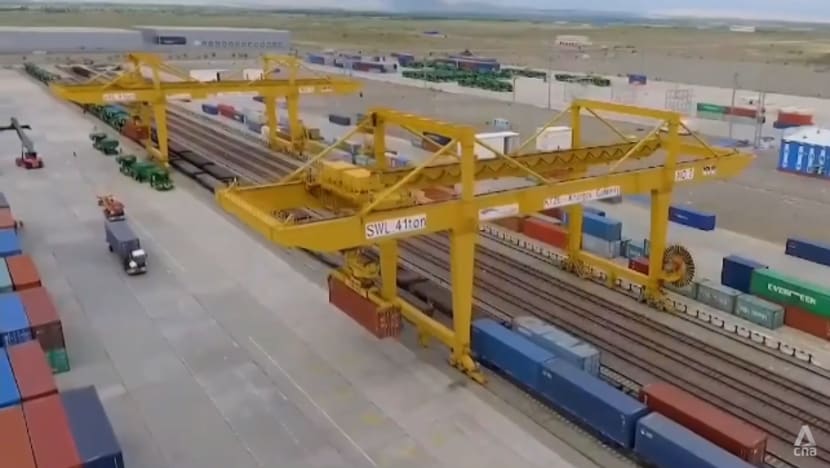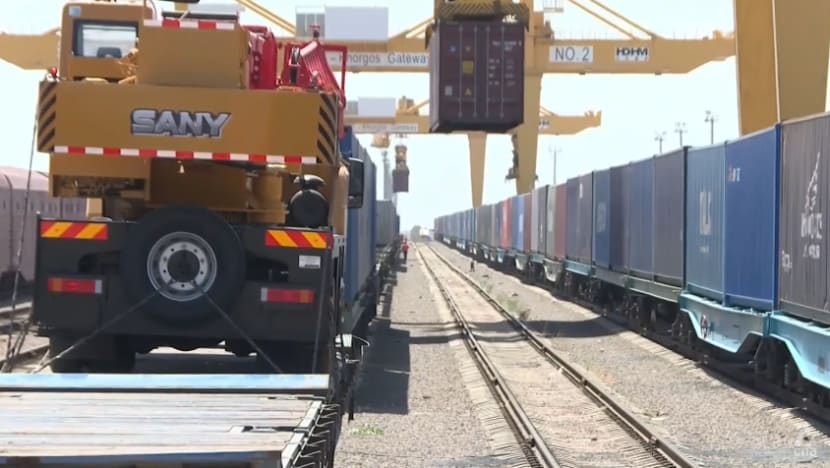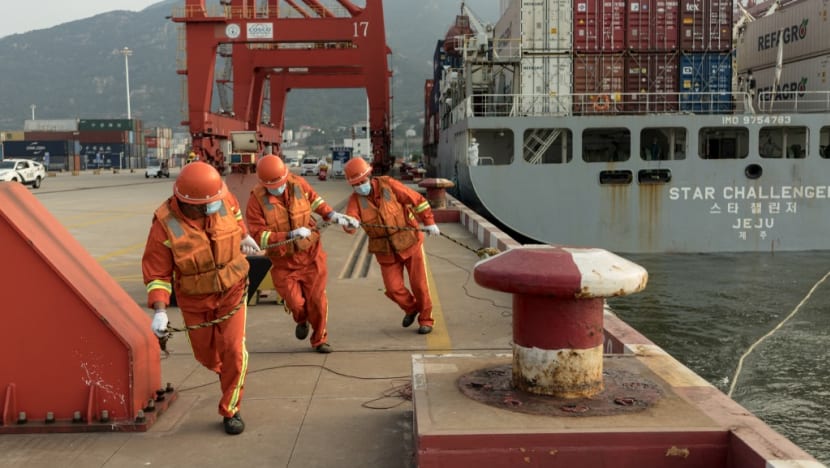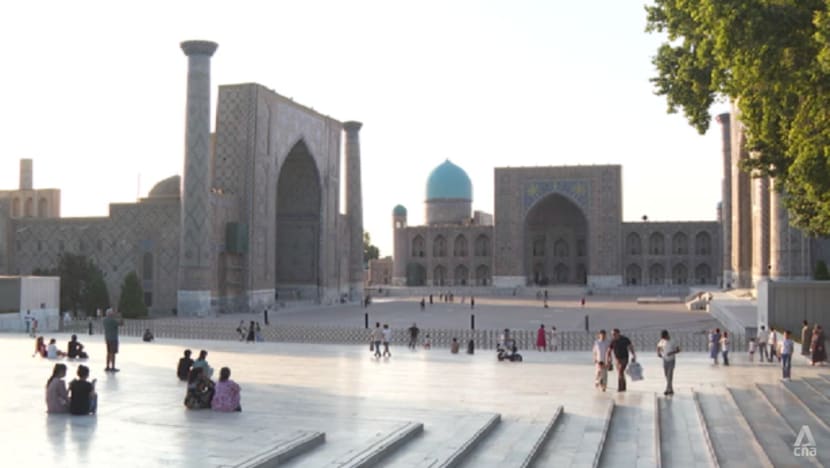A decade on, has China’s ambitious Belt and Road Initiative benefitted Central Asia?
As China marks the 10th anniversary of its global infrastructure project this year, CNA visits Central Asia, where the BRI was first set in motion, to take stock of the changes that have occurred.

The massive infrastructure project, sometimes referred to as the new Silk Road, aims to transform world trade by facilitating the shipment of goods from China to Europe by rail, instead of by sea.
CENTRAL ASIA: Ten years ago, Chinese President Xi Jinping first unveiled his vision for the Belt and Road Initiative (BRI) during a visit to Kazakhstan.
The massive infrastructure project, sometimes referred to as the new Silk Road, aims to transform world trade by facilitating the shipment of goods from China to Europe by rail, instead of by sea.
Since then, the vast global development drive has expanded rapidly across countries, and has significantly broadened China’s economic and political influence.
A decade on, Beijing said the investment strategy has generated over US$2 trillion in contracts worldwide.
As China gears up to host representatives of 130 countries for a forum this week celebrating the initiative's 10th anniversary, CNA visited Central Asia, where the BRI was first set in motion, to take stock of the changes that have occurred.
KAZAKHSTAN – STRATEGIC TRANSIT HUB
The “dry port” city of Khorgos, strategically located along China’s northwest border with Kazakhstan, is home to one of the most ambitious BRI projects – the Khorgos Gateway.
Here, goods from Chinese trains are transferred to Kazakh trains before making their way to Europe. This is because China’s railway gauge is narrower than Kazakhstan’s, and its trains are not able to run on Kazakh tracks.
The overland route through landlocked Central Asia saves more than half the time needed to transport the goods by sea.
The building and operation of the critical transit hub has helped to boost the local economy and create jobs for residents in the area.

However, growth has been slow in recent years, hampered by the COVID-19 pandemic. The ongoing Russia-Ukraine war has also forced operators of the railway to seek alternative routes.
“In light of these events, the volume of transshipment to Europe has dropped by about half. However, we have an alternative route – through the Caspian Sea, Azerbaijan, and Georgia,” said Mr Rustembekov Almas, an operations manager at Khorgos Gateway.
LOCALS WELCOME STRONGER CHINESE TIES
Critics of the BRI have accused Beijing of pursuing a “debt-trap diplomacy” by offering unaffordable loans to developing countries through the initiative.
Mr Almas said that while he is aware of the controversies surrounding the project, it has been a win-win situation on the ground so far.
“China is developing as a manufacturer and we are developing as a transit country. The end customers – Russia, Europe and Central Asia – also benefit from that. It’s all mutual. I cannot say that one party benefits more or takes advantage of another. Every party has a mutual interest in this,” he said.

Locals said they welcome the deeper economic connection with Beijing as they believe it could help the economy, and allow them access to cheaper goods from China.
“(Chinese goods) are not that bad quality and they are not too expensive. So (closer ties) are good and could be the beginning of the new Silk Road,” one local told CNA.
UZBEKISTAN – INCREASED CHINESE INVESTMENTS
Neighbouring Uzbekistan has also seen a steady increase in Chinese investments since signing up for the BRI.
According to several Chinese reports, the number of Chinese enterprises operating in the double-landlocked nation has grown to more than 2,000 last year, up from about 1,800 in 2021.
Dr Farkhod Tolipov, director of research institution Knowledge Caravan, which is based in the nation’s capital Tashkent, said that he is “both sceptical and optimistic” about the initiative and its impacts on Uzbekistan and the wider Central Asian region.
“(The BRI) is not without geopolitics – it does have a geopolitical dimension,” he said.
“But at the same time, with the assistance and the support of China, Central Asian countries are engaged in a number of projects that are so useful and so promising for the region.”
He cited the construction of the 19.2km Qamchiq tunnel, which connects people in the densely-populated Fergana Valley region to the rest of the country by rail.

Built by the China Railway Tunnel Group in collaboration with Uzbek Railways, the tunnel is the longest in Central Asia. It cuts the travel time between Fergana and Tashkent to about three hours.
Before its completion in 2016, residents had to spend twice that amount of time navigating a challenging drive through mountainous terrain.
TOURISM THROUGH SILK ROAD CHARM
Several Uzbek cities served as major trading centres in the days of the Silk Road more than 1,000 years ago.
Today, the nation is eager to attract international tourists by capitalising on its heritage as a node on the ancient trade route.
The government has set a target to boost tourism revenue to US$2.2 billion by 2025, more than double that of about US$1 billion in 2018.

Minister of Culture and Tourism Nazarbekov Ozodbek said Uzbekistan places so much importance on tourism that it did not slow its opening up even during the COVID-19 pandemic.
“We did not introduce strict requirements. Basically the main condition was to be vaccinated or take the PCR (polymerase chain reaction) test to enter the country. PCR testing sites were also opened in every border crossing point of Uzbekistan, like at airports,” he told CNA.
He added that a special presidential decree also provided for various benefits and supporting tools such as subsidies, loans, tax and other incentives to promote tourism development.
Last year, Uzbekistan received about 5.2 million foreign visitors, the majority from neighbouring Kazakhstan, Kyrgyzstan and Tajikistan.

To attract more visitors, Uzbekistan has established a visa-free regime for citizens of 86 countries, and e-visas for citizens of 57 countries.
However, experts said the country needs to overcome other hurdles such as weak transportation and payment systems, as well as the shortage of hospitality facilities, if it wants to become a sought-after place for tourists.
CHINA-CENTRAL ASIA RELATIONSHIP
Uzbekistan, Kazakhstan and other regional nations are hoping BRI projects will continue to attract more Chinese visitors and investments to the region.
After the collapse of the Soviet Union, Russia became the biggest trading partner for countries in Central Asia.
But in the last decade, China's investment in the region has been on the rise.
Last year, two-way trade between China and Central Asia hit a record US$70 billion.
Chinese President Xi Jinping in May pledged US$3.8 billion in financing support and grants for the region to bolster cooperation and development.
He vowed to upgrade bilateral investment agreements, encourage Chinese-funded businesses to create more jobs, and increase cross-border freight volume.
Experts say China could overtake Russia as the biggest trading partner of many Central Asian countries in the near future.


















